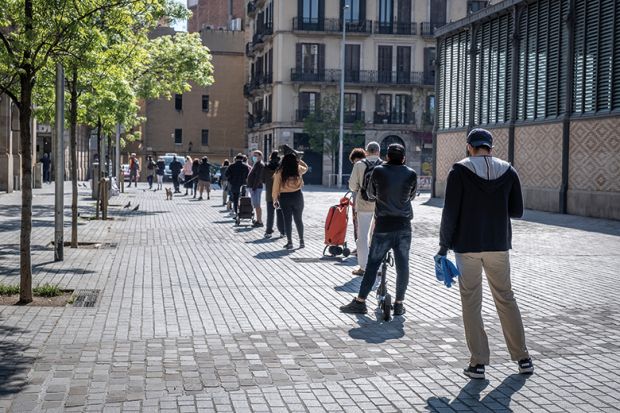As European countries tentatively relax their coronavirus lockdowns, universities have found themselves near the back of the queue for reopening, with campuses in several countries expected to stay largely closed to students until the next academic year.
In one sense, universities have become victims of their own success at teaching online, but some academics are concerned that continued closures could hurt poorer students without access to computers or study space, while others mourn the loss of face-to-face connection while teaching.
“Right now, the universities are not first in line when it comes to reopen[ing] society,” said Jesper Langergaard, director of Universities Denmark. In his country, campuses were shut and students sent home on 13 March, and will remain so until at least 10 May, despite kindergartens and primary schools reopening this week.
There are a few exceptions, with the government allowing universities to reopen for final-year medicine students, for example. “We do our best to continue both teaching and research, but we are looking forward to open[ing] again,” he said.
Meanwhile, in France, President Emmanuel Macron, announcing an extension of lockdown measures until mid-May, said earlier this week that physical university classes would not resume until the summer.
Germany is to allow smaller shops to reopen from 20 April, and schoolchildren facing leaving exams, along with final-year primary school pupils, will start returning to class from 4 May.
There is no word yet on exactly when universities might physically resume, although labs, archives and libraries can reopen, subject to distancing regulations. The academic body advising the German government on easing restrictions has concluded that older learners can cope better with distance courses, meaning younger pupils should be prioritised for physical teaching.
In both Germany and France, schools are being prioritised because policymakers fear home confinement will widen educational inequalities between rich and poor. “Too many children, especially in working-class neighbourhoods and in our countryside, are deprived of schooling without having access to digital technology and cannot be helped by their parents in the same way,” said Mr Macron, who wants a gradual reopening of schools and nurseries from 11 May.
But this digital divide also exists at university level, warned Catherine Carroll-Meehan, head of the School of Education and Sociology at the University of Portsmouth. “The educational inequalities are always there,” she said. “A crisis exacerbates them.”
On 23 March, Portsmouth was finally forced to finally close its library, but this has cut off a digital lifeline for students without access to a computer at home, she warned. “It’s in the heart of the city and the heart of the community,” she said.
Some are now sharing their home with five or six family members and need the library space to study, she added.
“If we’re going to talk about reopening, let’s talk about libraries, where you can practise social distancing,” she said.
As in Germany, Austrian schools are set to reopen in early May for pupils taking their leaving certificates, while small shops, garden centres and DIY stores reopened on 14 April.
But at universities there will be no more physical lectures this academic year, explained Sabine Seidler, president of Universities Austria. Still, “provided that the gradual opening begun [on 14 April] is successful, we will possibly be able to conduct laboratories and examinations with physical presence again to a limited extent in early summer”, she said.
Given that universities have long offered online and blended learning, a “large consensus” has emerged during the pandemic among international organisations giving advice on the educational response that they were better equipped than schools to teach at a distance, said Tia Loukkola, director of institutional development at the European University Association.
Nonetheless, as universities well understood prior to coronavirus, some face-to-face experiences are irreplaceable for students, she warned. For example, despite numerous predictions, the demise of physical libraries has, on the whole, failed to materialise, she pointed out – instead, they have become study and meeting places.
In Italy, which shut its universities as long ago as 5 March, Piero Ignazi, professor of political science at the University of Bologna, said there had been no discussion about reopening physical campuses. “As far as I know, the large majority of universities have introduced online learning systems, and it’s working quite well,” he said.
“The university community is quite silent” about the prospect of reopening, he added.
For Professor Ignazi personally, online teaching has worked far better than expected, with students less shy online than in real life, he observed.
But, ultimately, he wants a return to physical teaching. “Teaching should be face-to-face. I don’t know the reaction of students. How can I grasp if students understand what I’m saying? I can’t see the faces, the eyes,” he said.




